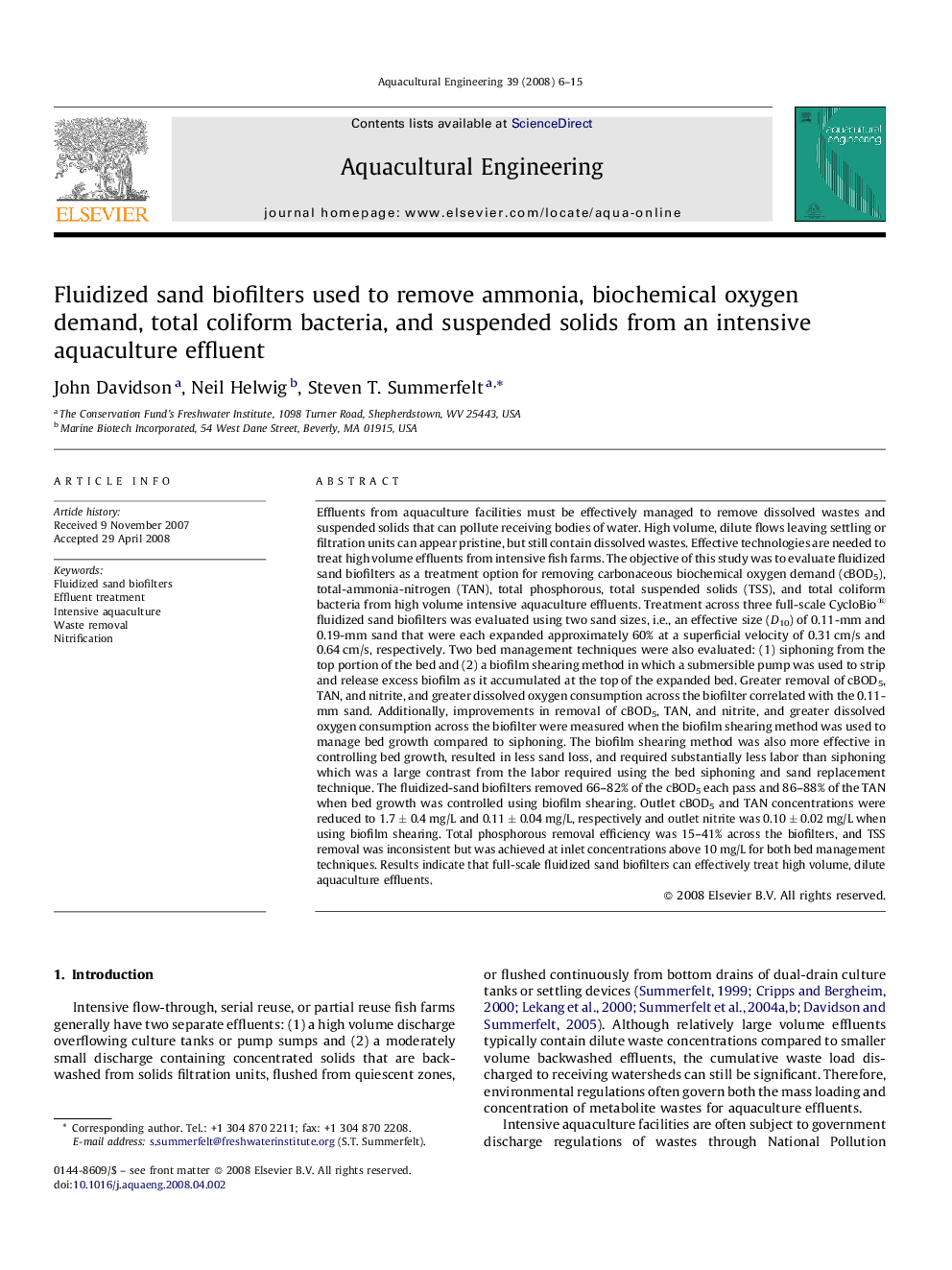| کد مقاله | کد نشریه | سال انتشار | مقاله انگلیسی | نسخه تمام متن |
|---|---|---|---|---|
| 6381549 | 1324100 | 2008 | 10 صفحه PDF | دانلود رایگان |
عنوان انگلیسی مقاله ISI
Fluidized sand biofilters used to remove ammonia, biochemical oxygen demand, total coliform bacteria, and suspended solids from an intensive aquaculture effluent
دانلود مقاله + سفارش ترجمه
دانلود مقاله ISI انگلیسی
رایگان برای ایرانیان
کلمات کلیدی
موضوعات مرتبط
علوم زیستی و بیوفناوری
علوم کشاورزی و بیولوژیک
علوم آبزیان
پیش نمایش صفحه اول مقاله

چکیده انگلیسی
Effluents from aquaculture facilities must be effectively managed to remove dissolved wastes and suspended solids that can pollute receiving bodies of water. High volume, dilute flows leaving settling or filtration units can appear pristine, but still contain dissolved wastes. Effective technologies are needed to treat high volume effluents from intensive fish farms. The objective of this study was to evaluate fluidized sand biofilters as a treatment option for removing carbonaceous biochemical oxygen demand (cBOD5), total-ammonia-nitrogen (TAN), total phosphorous, total suspended solids (TSS), and total coliform bacteria from high volume intensive aquaculture effluents. Treatment across three full-scale CycloBio® fluidized sand biofilters was evaluated using two sand sizes, i.e., an effective size (D10) of 0.11-mm and 0.19-mm sand that were each expanded approximately 60% at a superficial velocity of 0.31 cm/s and 0.64 cm/s, respectively. Two bed management techniques were also evaluated: (1) siphoning from the top portion of the bed and (2) a biofilm shearing method in which a submersible pump was used to strip and release excess biofilm as it accumulated at the top of the expanded bed. Greater removal of cBOD5, TAN, and nitrite, and greater dissolved oxygen consumption across the biofilter correlated with the 0.11-mm sand. Additionally, improvements in removal of cBOD5, TAN, and nitrite, and greater dissolved oxygen consumption across the biofilter were measured when the biofilm shearing method was used to manage bed growth compared to siphoning. The biofilm shearing method was also more effective in controlling bed growth, resulted in less sand loss, and required substantially less labor than siphoning which was a large contrast from the labor required using the bed siphoning and sand replacement technique. The fluidized-sand biofilters removed 66-82% of the cBOD5 each pass and 86-88% of the TAN when bed growth was controlled using biofilm shearing. Outlet cBOD5 and TAN concentrations were reduced to 1.7 ± 0.4 mg/L and 0.11 ± 0.04 mg/L, respectively and outlet nitrite was 0.10 ± 0.02 mg/L when using biofilm shearing. Total phosphorous removal efficiency was 15-41% across the biofilters, and TSS removal was inconsistent but was achieved at inlet concentrations above 10 mg/L for both bed management techniques. Results indicate that full-scale fluidized sand biofilters can effectively treat high volume, dilute aquaculture effluents.
ناشر
Database: Elsevier - ScienceDirect (ساینس دایرکت)
Journal: Aquacultural Engineering - Volume 39, Issue 1, August 2008, Pages 6-15
Journal: Aquacultural Engineering - Volume 39, Issue 1, August 2008, Pages 6-15
نویسندگان
John Davidson, Neil Helwig, Steven T. Summerfelt,